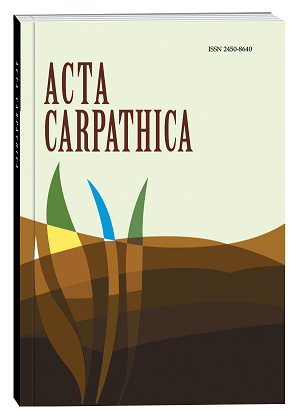QUALITY OF DRINKING WATER IN POPULATED POINTS OF SAMBIRSKA TERRITORIAL COMMUNITY
DOI:
https://doi.org/10.32782/2450-8640.2024.2.9Keywords:
Sambir Territorial Community, wells, drinking water, chlorides, phosphates, ammonium, nitrites, nitrates, mineralization, hardness.Abstract
The quality of drinking water in Ukraine, especially from decentralized sources, is a serious concern. Insufficient control over the quality of water from individual wells and boreholes, which are the primary source of water supply for the population of mountainous and foothill areas, leads to an increased risk of diseases. The situation is exacerbated by anthropogenic pressure on aquatic ecosystems, particularly in regions with oil extraction and refining, intensive agriculture, and unstable hydrological conditions. The Sambir district, like many other regions of Ukraine, is influenced by both natural and anthropogenic factors affecting the quality of water resources. The main problems include agricultural, municipal, and industrial wastewater, as well as the wash-off of pollutants from roads, industrial sites, and other areas during precipitation. The leaching of fertilizers and pesticides from fields during rains leads to increased levels of nitrates, phosphates, and other harmful substances in rivers and lakes. Ecosystem degradation and the pollution of all water sources make the protection of drinking water quality an urgent problem that needs to be addressed at all levels of government. We analyzed the quality of drinking water samples taken from wells located in the settlements of Sambir Territorial Community: Chernykhiv, Ralivka, Kruzhiky, and Novy Kalyniv. The results of the study showed that all samples were within the norm for organic parameters (transparency, odor, and taste). The pH level of the tested water varied from 6.0 to 7.3. Mineralization in drinking water in spring ranged from 323 to 980 mg/dm³. The content of chloride ions varied from 28.4 to 63.9 mg/dm³. The content of phosphates in water samples ranged from 0.035 to 0.073 mg/dm³. The concentration of NH4+ in water samples varied from 0.9 to 4.1 mg/dm³, exceeding the MPC in some places. The content of nitrites in water samples ranged from 0.0056 to 0.082 mg/dm³. The concentration of nitrates in water samples was from 11.3 to 18 mg/dm³. The water hardness ranged from 5.9 to 8.2 mmol/eq.dm³. The study showed that the content of the analyzed indicators in all drinking water samples was higher in autumn compared to spring values.
References
1. Бриндзя І., Гойванович Н., Білокур Л.. Екологічна характеристика басейну річки Дністер в межах Самбірського району. Acta Carpathica. № 1 (37), 2022. С. 26–35. DOI: https://doi.org/10.32782/2450-8640.2022.1.3.
2. Бриндзя І., Гойванович Н., Сеньків В. Екологічний стан децентралізованих джерел водопостачання Дрогобицького району. Acta Carpathica. 2024. № 1 (41). С. 48–58. DOI: 10.32782/2450-8640.2024.1.6.
3. Бриндзя І., Скробач Т. Якість криничної води Дрогобицької територіальної громади. Наукові записки Державного природничого музею. Вип. 38. 2022. С. 93–104.
4. Гойванович Н. К., Бриндзя І. В. Моніторинг якості криничних вод Жидачівського району Львівської області. Наукові записки Державного природничого музею. Вип. 37. Львів. 2021. С. 105–115.
5. Hoivanovych N., Antoniak H., Pavlyshak Yu., Bontei N. Quality analysis of water supply sources by hygienic indices using an example of the specialized regions in the Lviv region. Acta Carpathica. 2017. No. 28. P. 55–61.
6. Кропивницька Л., Бриндзя І., Мартинюк І., Каршень А., Стаднічук О. Оцінка екологічного ризику стану поверхневих вод річки Опір у межах Національного природного парку «Сколівські Бескиди». Acta Carpathica. 2022. № 2 (38). С. 22‒30. DOI:
https://doi.org/10.32782/2450-8640.2022.2.3.
7. Крупко Г., Суходольська І., Лико С., Логвиненко І. Оцінка нітратного забруднення питної води сільських населених пунктів Рівненської області. Науковий вісник Вінницької академії безперервної освіти. Серія «Екологія. Публічне управління та адміністру-
вання». 2023. Вип. 3. С. 119–128.
8. Левківський С. С., Падун М.М. Раціональне використання і охорона водних ресурсів : навч. посіб. Київ : Либідь, 2006. 60 с.
9. Петрук В. Г., Гайдей Ю. А., Вовк О. С. Аналіз стану якості питної води у колодязях м. Вінниці та Вінницької області. Збірник наукових праць ВНАУ. 2011. № 8 (48). С. 119–123.
10. Степова О. В., Рома В. В. Моніторинг поверхневих вод : навч. посіб. Полтава : ПолтНТУ, 2017. 21 с.
11. Хільчевський В. І., Хільчевський В. К., Осадчий В. І. Основи гідрохімії : підручник. Київ : Ніка-Центр, 2012. 312 с.
12. Цайтлер М., Бриндзя І., Досвядчинська М. Моніторинг довкілля : методичні вказівки для проведення лабораторних робіт. Дрогобич : Вид. відділ ДДПУ імені Івана Франка, 2014. 78 с.
13. Senkiv V., Bryndzia I. Spatial analysis of water quality indicators in Drohobych district. Acta Carpathica. 2023. No. 1 (39). Р. 16–27. DOI: https://doi.org/10.32782/2450-8640.2023.1.2.








